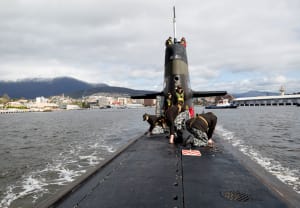Australia’s Collins Class submarine fleet will receive significant sonar upgrades to extend its regional superiority.
The Collins’ legacy cylindrical array will be replaced with a Modular Cylindrical Array (MCA) based on Sonar 2076 submarine technology developed by Thales teams in the UK. The existing flank array will be replaced by the latest generation flank array from Thales teams in France.
Thales will work with local industry, including Raytheon, to deliver the upgrades for the six submarines that will integrate products from other Australian providers including Sonartech Atlas, and L3 Oceania.
Minister for Defence Industry Christopher Pyne and Minister for Defence Marise Payne announced that work will commence this year.
The upgrades will better enable the submarines to safely navigate, detect and locate other vessels while remaining hidden themselves.
In a statement, Minister Pyne said the project demonstrates the maturity of the national submarine enterprise.
“Australian defence suppliers are central to the sovereignty of our current and future military capability,” Minister Pyne said. “As a result of their continued demonstration of expertise, Australian companies will have an enduring role in keeping our submarines superior and safe.”
Minister Payne said the upgrades are critical to maintaining Australia’s highly capable Collins Class submarine fleet until the introduction of the Future Submarines.
“The 2016 Defence White Paper clearly outlines the importance of a potent submarine capability to ensure our sovereignty and defend Australia,” Minister Payne said. “Submarines offer capabilities no other platform can provide, and that’s why the Turnbull Government is committed to investing in the Collins Class fleet to maintain its advantage in an increasingly complex and uncertain strategic environment.
“Enhancing the Collins Class’ high-end warfighting capabilities so they can continue to detect and locate other vessels, ensures it will be an effective deterrent to potential adversaries."

Thales Australia CEO Chris Jenkins also highlighted the importance of regional superiority.
“It is critical that Australia maintain the highest levels of submarine capability from the Collins fleet until the Future Submarine enters service. The sonar systems are the ‘eyes and ears’ of the submarines, and Thales will bring together the best underwater sensing technology from around the world to ensure the Collins remains a potent force," Jenkins said.
The project is valued at $542 million, with 70 per cent Australian industry content.
In the 2018–19 financial year, most of the spending will be on the design and production effort in NSW with Raytheon in Macquarie Park and Thales in Rydalmere.
The upgrades will then be installed at maintenance facilities at Osborne in South Australia and Henderson in Western Australia.



